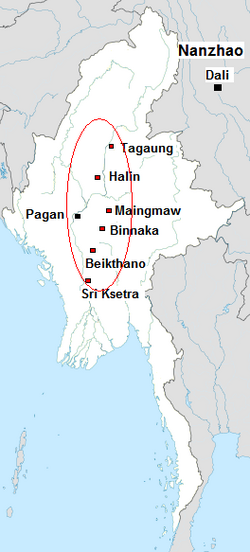Early Kingdom of Bagan ခေတ်ဦး ပုဂံ ပြည် | |||||||||
|---|---|---|---|---|---|---|---|---|---|
| c. 650 CE–1044 | |||||||||
 | |||||||||
| Capital | Arimaddana, Thiri Pyissaya, Tampawaddy, Pagan (Bagan) | ||||||||
| Common languages | Burmese | ||||||||
| Religion | Buddhism, animism, Hinduism | ||||||||
| Government | Monarchy | ||||||||
• 107–152 CE (chronicles) | Thamoddarit | ||||||||
• 167–242 (chronicles) | Pyusawhti | ||||||||
• 613–640 (chronicles) | Popa Sawrahan | ||||||||
• 846–886 | Pyinbya | ||||||||
• 956–1001 | Nyaung-u Sawrahan | ||||||||
| Historical era | Classical Antiquity | ||||||||
• Foundation | c. 650 CE | ||||||||
• ThiriPyissaya founded | 344–387 (chronicles) | ||||||||
• Tampawaddy founded | 516–523 (chronicles) | ||||||||
• Burmese calendar launched | 21 March 640 (chronicles) | ||||||||
• Pagan founded | 23 December 849 | ||||||||
• Disestablished | 16 December 1044 | ||||||||
| |||||||||
| History of Myanmar |
|---|
 |
|
|
|
|
|
|
The Early Pagan Kingdom (Burmese: ခေတ်ဦး ပုဂံ ပြည်) was a city-state that existed in the first millennium CE before the emergence of the Pagan Empire in the mid 11th century. The Burmese chronicles state that the "kingdom" was founded in the second century CE. The seat of power of the small kingdom was first located at Arimaddana, Thiri Pyissaya, and Tampawaddy until 849 CE when it was moved to Pagan (Bagan).
Radiocarbon dating shows the earliest human settlement in the Pagan region dates only from the mid-7th century CE. It existed alongside Pyu city-states that dominated Upper Burma. The city-state of Pagan, according to mainstream scholarship, was founded in the mid 9th century by the Mranma of Nanzhao Kingdom. Burmans at Pagan expanded irrigation-based cultivation while borrowing extensively from the Pyus' predominantly Buddhist culture. It was one of many competing city-states in the Pyu realm until the late 10th century when the principality began absorbing its surrounding states. The expansion accelerated in the 1050s and 1060s when King Anawrahta founded the Pagan Empire, the first ever unification of the Irrawaddy valley and its periphery.
